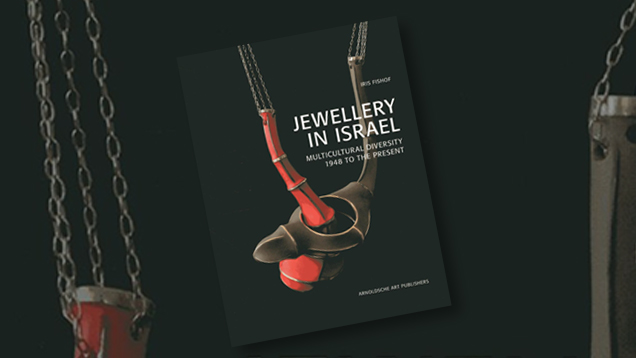Books: Jewellery in Israel: Multicultural Diversity 1948 to the Present
October 15, 2014

Fishof sets the stage in the first chapter, which traces Israeli jewelry to the earliest “souvenirs” made by Muslim artists in the region, primarily for Christian pilgrims to Jerusalem. Zionism, the movement to establish a Jewish state in Palestine, helped bring about the Bezalel School of Arts and Crafts in Jerusalem. Through many name and leadership changes, this school was to have a lasting influence on the jewelry of Israel.
Bezalel initially focused on developing a “Hebrew” style, with design motifs such as the Hebrew alphabet, Jewish symbols, biblical scenes, and the sites of the Holy Land. But with the rise of the Nazis during the 1930s and the first wave of European immigrants, including German metalsmiths steeped in the Bauhaus philosophy of unadorned simplicity, modernism began to take hold. It would shape the Israeli style for more than 30 years.
After the establishment of Israel in 1948, Jewish immigrants came from all over the world, doubling the region’s population. A chapter titled “The Melting Pot: 1950s to 1970s” describes how Jewish immigrants, urged to give up their cultural identity in favor of an Israeli one, struggled to make a living from the harsh land. Immigrants from Yemen, with centuries of Islamic jewelry design tradition behind them, had a strong and lasting impact. Because the ethnicity of Yemeni jewelry was not marketable to Israeli women of the time, Fishof describes how it was “adjusted to the demands and tastes of modern women by other craftsmen.” Essentially, the pieces were taken apart and reassembled into something more contemporary. One of the first contemporary designers to echo traditional styles using nontraditional components was Finy Leitersdorf. The desert-worn glass fragments in her designs presaged the use of non-precious metals in later designer jewelry.
In the 1960s, immigrants and Israeli designers who had studied abroad brought with them new influences. Israeli designers began experimenting with different styles and materials such as Perspex (Lucite) and found objects, integrating them into a native design aesthetic that had been developing in isolation for two decades.
At this point, jewelry artists began to have a substantial impact and the Bauhaus influence began to fade. And here the emphasis in Fishof’s book moves away from the effect of multicultural diversity and immigration on Israeli jewelry. Chapter 4, “International Recognition,” focuses on four Israeli artist jewelers whose work achieved international recognition—Bianca Eshel Gershuni, Vered Kaminski, Esther Knobel, and Deganit Stern Schocken. All were either born in Israel or immigrated with their parents at a very young age. These women became instructors at Bezalel, where their work continues to guide emerging Israeli artists.
In the final chapter, “The Contemporary Scene,” Fishof brings us to the present, and demonstrates how far Israeli jewelry has come from the early “Hebrew style.” Yet many of these influences are still there, particularly the use of botanical and religious images, although these are often more abstract now. There are pieces based on motifs from both rural and urban areas of Israel. The work is often narrative, meant to tell or comment on personal or family stories, such as a necklace by Knobel that is “shaped like the actual pine needle necklaces habitually made by children in Israel.” As Israel is a country that has spent the last 70-plus years forging an identity in a climate of conflict, many pieces incorporate the topic of war.
Like many other artist jewelers from around the world, Israeli contemporary jewelry artists often use non-precious materials. In Israeli jewelry, these may include broken tiles, stones, protective steel mesh, or crushed beverage cans.
In her final chapter, Fishof asks, “Is there a concept such as Israeli jewelry?” She concludes that there is. On my first reading, I disagreed: Many art jewelry designers today use less-expensive or even throwaway materials, incorporate elements from their surroundings, and tell personal or even painful narratives. But on a second reading, I changed my mind. What better source for a national design concept than images, colors, and materials taken from the artist’s surroundings and drawn from their cultural or artistic heritage?
Any book that documents the jewelry history of a people must be well illustrated in order to demonstrate the points the author is making. A difficult task, yet Jewellery in Israel is richly illustrated with black-and-white as well as color images—many of them full-page.
The history is a bit choppy at times. Yemeni silversmiths are mentioned in the first chapter, leading the reader to believe they were part of the pre-state jewelry manufacturing in Israel. Only in the second chapter do we learn that most of them immigrated in the 1940s, after Israel became a state. Some of the difficulties with the narrative flow, however, may be due to the book’s migration through translation.
I would have been interested to learn of any Palestinian influence on Israeli jewelry design. Fishof mentions the conflict’s effect on the narrative in the jewelry but doesn’t say whether there is design influence as well. Fishof also acknowledges the recent influx of African immigrants, though it may be too early to know what influence they will have on Israeli jewelry.
All in all, this a recommended read for anyone interested in ethnic or contemporary art jewelry from Israel, a country whose impact on jewelry design is greater than its geographic size or age might suggest.
About the Reviewer
Sharon Elaine Thompson is a Graduate Gemologist (GG) and Fellow of the Gemmological Association of Great Britain (FGA). She has been an instructor at the Gemological Institute of America, and has written extensively on jewelry and jewelry manufacturing for more than 25 years. She is currently working on a book on jewelry design, Good Bones: The Elements and Principles of Design for Jewelry Makers, under contract to Brynmorgen Press.



